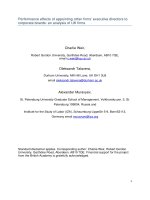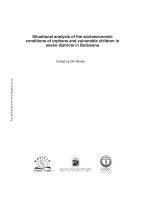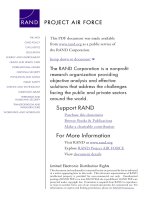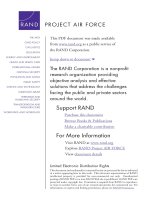ANALYSIS OF POLYSACCHARIDE STRUCTURES
Bạn đang xem bản rút gọn của tài liệu. Xem và tải ngay bản đầy đủ của tài liệu tại đây (818.45 KB, 25 trang )
3 Analysis of Polysaccharide Structures
A broad variety of specific methods for the structure analysis of polysaccharides,
their interaction with different compounds such as solvents or inorganic salts, and
the superstructures both in solid state and in solution have been established. An
overview of methods and results for the superstructural behaviour of polysaccha-
rides is given in [19]. The aim of this chapter is to present a review of the techniques
that can be performed on commercially available equipment to elucidate the pri-
mary structure of polysaccharides.
It is an essential prerequisite to analyse the polysaccharides before modification
as comprehensively as possible to monitor all types of structural changes of the
polymer backbone during the conversion to a derivative. One should always keep
in mind that purification beyond the removal of low molecular mass impurities
is not reasonable. The basic RU of the polysaccharides described in the book are
given in Chap. 2. Nevertheless, analysis of the polysaccharide in question is always
recommended because the chemical structure, including branching, sequences of
sugar units, oxidised moieties in the chain (e.g. aldehyde-, keto-, and carboxylic
groups in polyglucans), and the residual amount of naturally occurring impurities
vary for a given type of polysaccharide, especially for fungal and plant polymers,
and may significantly influence the properties and reactivity.
A number of basic chemical methods have been developed for the structure
analysis and the determination of the purity of polysaccharides. Most of these
chemical analyses are colour reactions, which can be quantified by UV/Vis spec-
troscopy. A list of methods and the features determined is shown in Table 3.1.
In addition, for ionic polymers such as alginates or chitosan salt, titration can
be exploited to obtain information about the number of functional groups within
the polymer. Linear potentiometric titration is used for the determination of free
amino functions in chitinous materials [45].
A value that should be analysed carefully before conversion of a polysaccharide
to an ester is the amount of absorbed water in the starting polymer. This is possible
by thermogravimetry or by amperometric titration with Karl Fischer reagent after
water extraction. In the case of cellulose extraction, the most suitable extractants
are DMF, acetonitrile and isobutanol [46].
16 3 Analysis of Polysaccharide Structures
Table 3.1. Summary of chemical methods used for structure determination of polysaccharides
Test Me t ho d
λ
max
(nm) Detected structure Ref.
Anthron Anthron 620 Free and bound hexose [41]
in H
2
SO
4
on polysaccharides
Blue: hexose, Green: other sugars
Oricinol Oricinol in EtOH 665 Free and bound pentoses [40]
and FeCl
3
in HCl on polysaccharides
Green to blue: pentose produce
green to blue coloration
Phenol/ Phenol 485 Free and bound sugars in soluble and [41]
H
2
SO
4
and H
2
SO
4
insoluble polysaccharides
Biphenylol Hydroxybiphenylol 520 Free and bound uronic acid [42]
in NaOH and borax on polysaccharides (red to blue)
in H
2
SO
4
Cystein/ Cystein-HCl in H
2
O 380, 396, Free and bound 6-desoxyhexose [40]
H
2
SO
4
and H
2
SO
4
427 on polysaccharides
PAHBAH PAHBAH in HCl 410 Reducing sugars [43]
and NaOH
Updegraff AcOH/H
2
O/ Cellulose [44]
HNO
3
(8:2:1)
3.1 Optical Spectroscopy
Besides the above-mentioned analysis of polysaccharides with UV/Vis spec-
troscopy after chemical treatment, optical spectroscopy is used for some semi-
quantitative methods for the determination of the amount of functional groups
(NH-CO-CH
3
, COOH). The DDA value in chitinous material can be determined via
UV/Vis measurements at 210 nm after dissolution in 85% phosphoric acid under
thermal-controlled sonication [47].
Optical spectroscopy can be used to determine the conformation of structural
features of pure polysaccharides and to easily monitor structural changes during
modification. FTIR spectroscopy yields “fingerprint” spectra usable as structural
evidence. The most common way for FTIR measurements is the preparation of
KBr pellets. To obtain well-resolved spectra, it is necessary to apply a ball mill to
guarantee homogeneous mixtures of KBr and the macromolecule. Usually, samples
containing about 1–2% (w/w) polymer are prepared. Common “non-polymer”
signals observed by means of FTIR spectroscopy are adsorbed water at about
1630–1640 cm
−1
and CO
2
at about 2340–2350 cm
−1
. A number of FTIR spectra
obtained for the glucanes cellulose, starch, dextran and scleroglucan are shown in
Fig. 3.1. The general assignment is given in Table 3.2.
Alginates show additional signals for the C=O moiety of the carboxylate at
1620–1630 and 1410–1420 cm
−1
or at 1730 cm
−1
, if the alginate is transferred to
3.1 Optical Spectroscopy 17
Fig. 3.1. FTIR spectra of the glucanes A cellulose, B starch, C dextran and D scleroglucan
Table 3.2. General assignment of FTIR spectra of polysaccharides (adapted from [48])
Wave number (cm
−1
) Assignment
3450–3570 OH stretch, intramolecular H-bridge between the OH groups
3200–3400 OH stretch, intermolecular H-bridge between the OH groups
2933–2981 CH
2
antisymmetric stretch
2850–2904 CH
2
symmetric stretch
1725–1730 C
=
O stretch from acetyl- or COOH groups
1635 Adsorption of water
1455–1470 CH
2
symmetric ring stretch at pyrane ring; OH in-plane deformation
1416–1430 CH
2
scissors vibration
1374–1375 CH deformation
1335–1336 OH in-plane deformation
1315–1317 CH
2
tip vibration
1277–1282 CH deformation
1225–1235 OH in-plane deformation, also in COOH groups
1200–1205 OH in-plane deformation
1125–1162 C–O–C antisymmetric stretch
1107–1110 Ring antisymmetric stretch
1015–1060 C–O stretch
985–996 C–O stretch
925–930 Pyran ring stretch
892–895 C-anomeric groups stretch, C1–H-deformation; ring stretch
800 Pyran ring stretch
18 3 Analysis of Polysaccharide Structures
the acid form (see Table 3.3). A semi-quantitative determination of the ratios of
the two sugar residues in the polymer is possible by comparing the peak areas
in spectra at 808 cm
−1
for
β
-d-mannuronic acid and 887 cm
−1
for
α
-l-guluronic
acid [49].
Table 3.3. Characteristic bands for alginates and galactomannanes in FTIR spectra (ν in cm
−1
,
adapted from [50])
Alginic acid Sodium alginate Mannan Galactomannan
1730 – –
1610 1605 1630 –
– 1405 – 1635
920 935 935 –
870 880 870 –
805 810 805 860
– – 760 805
660 – – 760 (weak)
– – 600
Galactomannans show characteristic FTIR signals at 870 cm
−1
andintherange
805–820 cm
−1
[50]. Via FTIR spectroscopy, the glucans and mannans isolated
from yeast, e.g. Saccharomyces cerevisiae, can be analysed for composition using
a characteristic mannan signal at 805 cm
−1
[51]. The amount of xylan in ligno-
celluloses can be determined by evaluation of the carboxyl bands at 1736 cm
−1
in
deconvoluted FTIR spectra [52].
Chitin possesses typical signals at 1650, 1550 and 973 cm
−1
, which are the
amide I,IIandIIIbandsrespectively. A sharp signal appears at1378 cm
−1
,causedby
the CH
3
symmetrical deformation. The amount of N-acetylation can be estimated
from the signal areas of the bands at 1655 and 3450 cm
−1
, according to the following
equation [53].
% N(acetyl)
=
A
1655
A
3450
· 115 (3.1)
3.2 NMR Spectroscopy
The most powerful tool for polysaccharide analysis is NMR spectroscopy. For
the majority of these biopolymers, well-resolved
1
H-,
13
C- and two-dimensional
NMR spectra can be acquired from solutions of the intact polymers in DMSO-
d
6
,inD
2
O, and in other deuterated solvents (solubility, see Table 5.1 in Chap. 5,
chemical shifts of the solvents, see Table 8.2 in Chap. 8). Restrictions exist only
for cellulose and chitin, which are not easily soluble, and for guar gum, alginates
3.2 NMR Spectroscopy 19
and scleroglucanes, which lead to highly viscose solutions at low concentrations,
yielding badly resolved spectra. In the case of cellulose and chitin, the application
of solid state NMR spectroscopyor the use of specific solvents are necessary. For the
other polysaccharides, careful acidic degradation is recommended (see Sect. 3.2.4).
3.2.1
13
C NMR Spectroscopy
For
13
C NMR spectroscopy, solutions containing 8 to 10% (w/w) polymer should
be used, if the viscosity of the solutions permits. In order to circumvent problems
due to high viscosity, polymer degradation by means of acidic hydrolysis (see
Table 3.17) and ultrasonic degradation may be applied [54]. The measurements
shouldbe carried out atelevated temperature. Ifthepolysaccharides do not dissolve
sufficiently in DMSO, brief heating to 80
◦
C can be helpful, or the addition of small
amounts of LiCl. The solvent applied has an influence on the chemical shifts of the
signals. Measurements in D
2
O commonly lead to a downfield shift (higher ppm
values) in the range of 1–2 ppm. In Table 3.4, an overview of relevant chemical
shifts and corresponding carbon atoms for
13
C NMR signals of polysaccharides is
given.
Table 3.4. General overview of chemical shifts and the corresponding carbon atoms for
13
C NMR
signals of polysaccharides
C atom (moiety) Chemical shift (ppm)
C-1 (
β
) 103–106
C-1 (
α
) 98–103
Involved in glycosidic bond, non-anomeric C 77–87
C-2 to C-5 65–75
CH
2
OH 60–62
C
=
O (carboxylic acid moieties) 175–180
COOH 170–175
O–CH
3
55–61
O–(C
=
O)CH
3
20–23
CH
3
15–18
A detailed assignment of a variety of polysaccharides described in this book is
shown in Table 3.5. In general, the signals for the carbon atoms of the glycosidic
linkages (C-1) indicate the type of anomer the RU represents. Thus, polymers built
up from
β
-anomers show a C-1 signal at about 103 ppm,e.g.curdlan(Fig.3.2)or
cellulose (Fig. 2.1).
Polymers consisting of
α
-anomers yield signals at approximately 98–100 ppm
for C-1. The involvement of C-3, C-4 or C-6 in a glycosidic linkage is usually
20 3 Analysis of Polysaccharide Structures
Table 3.5. Detailed assignment of
13
C NMR shifts of polysaccharides
Polysaccharide Chemical shift (ppm) Ref.
C-1 C-2 C-3 C-4 C-5 C-6
Scleroglucan (DMSO-d
6
) 104.6 74.1 88.0 70.0 76.5 70.1 [55]
Galactomannan– 101.5 71.2 72.0 72.2 73.8 63.9 [56]
galactose (D
2
O)
Pullulan (1→4)- 98.8 72.1 74.2 78.7 72.1 61.8 [57]
(1→6)-(1→4)
Glc (D
2
O)
Curdlan (DMSO-d
6
) 103.0 72.8 86.2 68.4 76.3 60.8 [51]
Dextran (D
2
O) 98.1 71.8 73.3 70.0 70.3 66.0 [58]
Starch (DMSO-d
6
) 99.9 71.5 73.1 78.6 69.9 60.4
Alginate 102.2 67.4 71.8 80.3 69.9 177.1 [59]
103.9 73.3 74.3 82.6 78.9 177.6
Xylan 101.5 72.4 73.8 75.3 63.0 –
Inulin 62.1 103.8 78.0 75.4 82.5 62.4
Cellulose 103.9 74.9 76.6 79.8 76.6 60.6
in DMAc/LiCl
Chitosan 100.5 58.7 73.0 794 77.7 62.9
in CD
3
COOD
Fig. 3.2.
13
C NMR spectrum of curdlan from Alcaligenes faecalis in DMSO-d
6
3.2 NMR Spectroscopy 21
indicated by a downfield shift (towards higher ppm values) of the corresponding
13
C signal in the range of 7–11 ppm. The C-4 signal of (1→4)-glucans such as
cellulose and starch is at approximately 78 ppm and the C-6 signal at approximately
60 ppm. In contrast, the C-4 peak of the (1→6)-glucan dextran is at 70 ppm and
the C-6 signal at 67 ppm (Fig. 3.3, [58]).
A comparable assignment (Table 3.5) is found for polysaccharides consisting
of sugars other than glucose. The spectra of inulin (fructan) and xylan (consisting
mainly of xylose) show signals for the glycosidic C-1 at 101–104 ppm,forthe
CH
2
OH moiety at 62–63 ppm, and for the secondary C-atoms in the range 72–
83 ppm. In the case of inulin, two peaks at 62.1 and 62.4 ppm are observed for the
primary carbon of the fructose and the glucose units. The carbonyl signal of the
carboxylate moieties in xylan is usually not visible for purified samples, and thus
the
13
C NMR spectrum shows five sharp peaks.
Fig. 3.3. Comparison of the
13
C NMR spectra of A dextran from Leuconostoc spp. (M
w
6000 g/mol,
in DMSO-d
6
, subscript s denotes branching points) and B starch (maize starch with 28 % amylose, in
DMSO-d
6
)
The C-1 and C-6 signals are particularly sensitive and therefore suitable to
determine different substructures in polysaccharides by means of
13
C NMR spec-
troscopy. The existence of the maltotriose units in pullulan can be rapidly con-
cluded from the occurrence both of three separate signals for the C-1 atom at 98.6,
100.6 and 101.4 ppm, and for C-6 at 60.2, 60.8 and 66.9 ppm (Fig. 3.4, assignment,
22 3 Analysis of Polysaccharide Structures
see Table 3.6) [57]. In the case of well-resolved
13
C NMR spectra of high molecular
mass dextran (M
w
60 000 g
/
mol), signals at 61 ppm indicate a C-6 with an unmod-
ified hydroxyl group. A (1→3) linkage of the RU occurs, as can be concluded from
a small signal for a substituted C-3 at about 77 ppm.
Fig. 3.4.
13
C NMR spectrum of pullulan from Aureobasidium pullulans in DMSO-d
6
Table 3.6. Assignment of
13
C NMR signals of pullulan in D
2
O (adapted from [57])
Pullulan Chemical shift (ppm)
C-1 C-2 C-3 C-4 C-5 C-6
(1→4)-(1→6)-(1→4) Glc 98.8 72.1 74.2 78.7 72.1 61.8
(1→4)-(1→4)-(1→6) Glc 100.7 72.4 74.2 78.2 72.1 61.5
(1→6)-(1→4)-(1→4) Glc 101.1 n.d. 74.0 70.6 71.3 67.6
The signal for the adjacent carbon (C-5) is shifted to lower field for carboxylic
acid moieties at the polymer backbone (uronic acids), e.g. in algal polysaccharides
(alginate). In alginates, the C-5 signal is found at about 78 ppm.Foralginatesbuilt
up of
β
-d-mannuronic acid and
α
-l-guluronic acid units, a sequence analysis can
be performed. The C-5 (≈ 78 ppm), C-4 (≈ 81 ppm)andC-1(≈ 103 ppm)signals
3.2 NMR Spectroscopy 23
are strongly influenced by the sequence of the different acids (Fig. 3.5), and can
be used to gain insight into the type of linkage present and the amount of the
subunits. To apply
13
C NMR spectroscopy to alginates, it is usually necessary to
employ hydrolytic degradation to obtain solutions with a reasonable viscosity.
However, the degradation may lead to undesired side reactions.
Fig. 3.5.
13
C NMR spectra of alginates from bacteria with different amounts of
α
-l-guluronic acid
units. Underlined M (d-mannuronic acid) and G (l-guluronic acid) denote signals from M and G
residues respectively, whereas letters not underlined denote neighbouring residues in the polymer
chain. Numbers describe which protonin the hexose is causing the signal (reproduced with permission
from [60], copyright The American Society for Biochemistry and Molecular Biology)
The use of solution state
13
C NMR spectroscopy is limited for untreated galac-
tomannans. Nevertheless,
13
C NMR spectra of galactomannans from locust bean,
guar and fenugreek gums have been obtained and the peaks were assigned for
24 3 Analysis of Polysaccharide Structures
partially hydrolysed samples. Assignment of the splitting of the mannosyl C-4
resonances can be used for the calculation of the mannose:galactose ratios in the
hydrolysed gums (Table 3.7, [56]).
Table 3.7. Assignment of
13
C NMR signals of galactomannan in D
2
O (adapted from [56])
Repeating unit Chemical shift (ppm)
C-1 C-2 C-3 C-4 C-5 C-6
Galactose 101.5 71.2 72.0 72.2 73.8 63.9
Mannose, unsubstituted 102.8 72.8 74.2 79.1 77.7 63.3
Mannose, substituted 102.7 72.6 74.1 79.6 76.0 69.2
For polysaccharides insoluble in DMSO or water, such as cellulose or chitin, the
application of solid state
13
C NMR may be used. Besides the structural information
on the RU and modified RU, the spectra reveal supramolecular features [61]. Owing
to the supramolecular interactions, the signals are shifted generally to lower field
(higher ppm), as shown in Table 3.8 for C-1, C-4 and C-6 signals of cellulose.
Table 3.8. Chemical shifts for C-1, C-4 and C-6 signals of cellulose in solid state
13
C NMR spectra,
compared with data for cellulose dissolved in DMAc/LiCl (adapted from [62])
Polymorph
13
C Chemical shifts (ppm)
C-1 C-4 C-6
Cellulose in LiCl/DMAc 103.9 79.8 60.6
Cellulose I 105.3–106.0 89.1–89.8 65.5–66.2
Cellulose II 105.8–106.3 88.7–88.8 63.5–64.1
Cellulose III 105.3–105.6 88.1–88.3 62.5–62.7
Amorphous cellulose ca. 105 ca. 84 ca. 63
Solid state
13
C NMR spectroscopy of chitin shows an upfield shift of the C-2
signal to about 58 ppm, compared to cellulose. The technique can be used to
calculate the degree of N-acetylation from the signal ratio of the methyl moieties
of the acetyl function at about 21 ppm versus the carbons of the AGU in the range
58–103 ppm [47].
For solution
13
C NMR investigation of cellulose and chitin, specific solvents
must be applied. Cellulose can be measured in solvents, e.g. DMSO-d
6
/TBAF,
ionic liquids or salt melts. A spectrum of cellulose dissolved in DMSO-d
6
/TBAF is
showninFig.2.1.ThechemicalshiftsoftheAGUcarbonsignalsdependonthe









